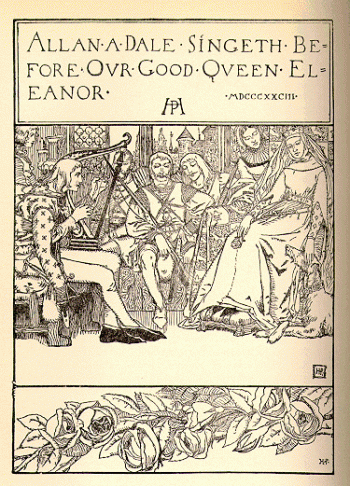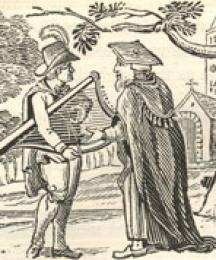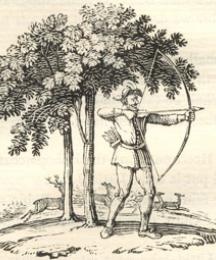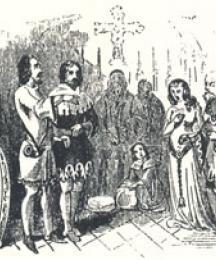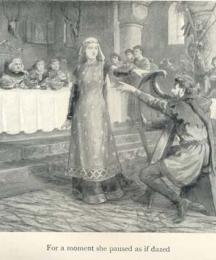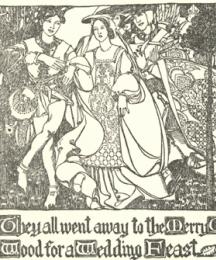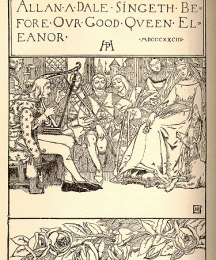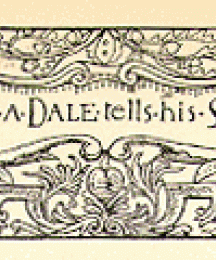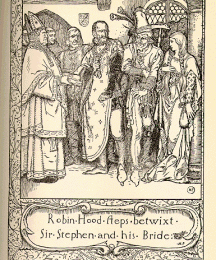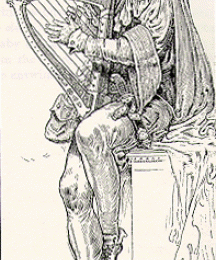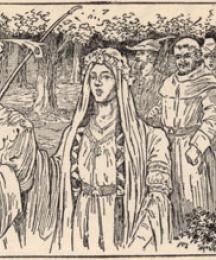Read Less
Alan a Dale is a character who found his way into the Robin Hood tradition. Not present in the major early long ballads or the
Gest of Robin Hood, he is first mentioned in a seventeenth-century ballad in a story where Robin and the outlaws save a young man’s beloved from being married to an older wealthy man, and in a tricksterish spirit they supervise her marriage to Alan himself. With his name variously spelt, he became a minor and intermittently recurrent member of the outlaw band, but his romantic heroism was not forgotten, and occurs in some nineteenth-century fiction and subsequent story. Later Alan gained the characteristic of bringing music into the outlaw band, being used as a musical commentator in some elements of the film tradition, with the honour of being played by Bing Crosby in the 1964 musical
Robin and the Seven Hoods. More recently he recurs as just one of the outlaws, but his musical capacity has re-emerged in the 2010 film starring Russell Crowe.
The earliest version of the Alan a Dale story is found in a broadside ballad from the printer Francis Coles and his partners, preserved in the collections of ballads made by Francis Douce, Samuel Pepys and the Duke of Roxburgh: F. J. Child suggested that a version of this could have originated from any part of the period 1655-80 when Coles was working with other printers, but according to the more recent
English Short-Title Catalogue the earliest version comes from the period between 1674-79.
This ballad begins with the familiar “Robin meets a stranger in the forest” opening:
As Robin Hood in the forrest stood,
All under the green-wood tree,
There was he ware of a brave young man,
As fine as fine might be.
The youngster was clothed in scarlet red,
In scarlet fine and gay,
And he did frisk it over the plain,
And chanted a roundelay.
But in an unusual move nothing happens, and next day he re-appears in a very different mode:
As Robin Hood next morning stood,
Amongst the leaves so gay,
There did he espy the same young man,
Come drooping along the way.
The scarlet he wore the day before,
It was clean cast away;
And every step he fetcht a sigh,
“Alack and a well a day!”
The outlaws take him to their stronghold, and Robin inquires “courteously” if he has any money for them:
“I have no money,” the young man said,
“But five shillings and a ring;
And that I have kept this seven long years,
To have it at my wedding.
“Yesterday I should have married a maid,
But she is now from me tane,
And chosen to be an old knights delight,
Whereby my poor heart is slain.”
He gives his name as “Allin a Dale” and Robin asks how much he will give them to recover his true love:
“I have no money,” then quoth the young man,
“No ready gold nor fee,
But I will swear upon a book
Thy true servant for to be.”
The outlaws are sympathetic: the wedding is to occur only five miles away, and they spring into action, with Robin, as in his gallows rescues, using a version of disguise to intervene in events:
Then Robin he hasted over the plain,
He did neither stint nor lin,
Until he came unto the church,
Where Allin should keep his wedding.
“What dost thou here?” the bishop he said,
“I prethee now tell to me.”
“I am a bold harper,” quoth Robin Hood,
“And the best in the north countrey.”
“O welcome, O welcome,” the bishop he said,
“That musick best pleaseth me.”
“You shall have no musick,” quoth Robin Hood,
“Till the bride and the bridegroom I see.”
With that came in a wealthy knight,
Which was both grave and old,
And after him a finikin lass,
Did shine like glistering gold.
“This is no fit match,” quoth bold Robin Hood,
“That you do seem to make here;
For since we are come unto the church,
The bride she shall chuse her own dear.”
To enforce such a spirit of female liberty the apparent harper, as on so many occasions, deploys his horn to call up the outlaw band – who already include Alan:
Then Robin Hood put his horn to his mouth,
And blew blasts two or three;
When four and twenty bowmen bold
Came leaping over the lee.
And when they came into the church-yard,
Marching all on a row,
The first man was Allin a Dale,
To give bold Robin his bow.
“This is thy true love,” Robin he said,
“Young Allin, as I hear say,
And you shall be married at this same time,
Before we depart away.”
“That shall not be,” the bishop he said,
“For thy word shall not stand;
They shall be three times askt in the church,
As the law is of our land.”
The resistance to the bishop and the “grave and old” “wealthy knight” is not on this occasion by force, but in the spirit of carnival associated with the Robin Hood may-games, and also evident in many ballads:
Robin Hood pulld off the bishops coat,
And put it upon Little John;
“By the faith of my body,” then Robin said,
“This cloath doth make thee a man.”
When Little John went into the quire,
The people began for to laugh;
He askt them seven times in the church,
Least three times should not be enough.
“Who gives me this maid,” then said Little John;
Quoth Robin, “That do I,
And he that doth take her from Allin a Dale
Full dearly he shall her buy.”
And thus having ended this merry wedding,
The bride lookt as fresh as a queen,
And so they returnd to the merry green wood,
Amongst the leaves so green.
This ballad was evidently popular, with four surviving broadside versions, but it appears not to have entered the early mainstream of outlaw narratives, as it is not in any of the early “garlands,” or ballad-collections, that appeared in 1663, 1670, 1684-6 and 1689. It is however among the seven Robin Hood ballads in the 1723
Collection of Old Ballads and then seems to become a classic, being in the 1749 garland, in the undated “Aldermary” garland of the mid eighteenth century and also the late York garland of 1811. It appears in Thomas Evans’s 1777
Old Ballads, which is closely followed in both order and content (with some additions) by Joseph Ritson in his 1795 collection,
Robin Hood.
The ballad has textual complexities. The story itself appears before Coles’s print version, being also found in the Sloane
Life of Robin Hood--but not about Alan a Dale. This manuscript, now in the British Library, is usually dated around 1600, but in the opinion of Thomas Hahn might well be some twenty years earlier. The events of the
Life are primarily taken from pre-existing stories, notably the
Gest, but it also tells the story of how Robin met Little John, and how he, John, and Will encountered the Pinder of Wakefield. These stories are found in ballads preserved later--a good deal later in the case of Little John. In the Sloane
Life the story of the re-arranged wedding is told about Robin’s first meeting with his other regular supporter, Will Scarlock.:
one day meting him, as he walked solitary, and lyke to a man forlorne, because a mayd to whom he was affianced was taken from him by the violence of her friends, and giuen to another that was auld and welthy. Whervpon Robin, vnderstanding when the maryage-day should be, came to the church, as a beggar, and having his company not far of, which came in so sone as they hard the sound of his horne, he toke the bride perforce from him that was in hand to have maryed her, and caused the preist to wed her and Scarlocke together.
(Text from J. M. Gutch, ed.,
A Lyttel Gest of Robin Hood and Other Auncient and Modern Ballads Relating to the Celebrated Yeoman, 2 vols, London, Longman, 1847)
Another version of this story is found in the “Forresters Manuscript,” which was discovered in Britain in 1993. This is a handwritten collection of Robin Hood ballads, datable around 1670, and apparently prepared as copy for a garland that never appeared. As the four it did not contain which were in the actual 1670 garland are copied without editorial changes at the end of the manuscript, and their titles are squeezed in at the bottom of the title-page, it would appear they were added to the manuscript after that garland appeared, which presumably meant this prepared version was no longer marketable.
The “Forresters Manuscript” contains no previously unknown ballads, though its version of “Robin Hood and Queen Katherine” is clearer than the broadside version, which may have been cut down a little to fit the space, and it has a longer version of “The Pinder of Wakefield” (as well as the pre-existing short version), and some other ballads have been edited a fair amount. Its second ballad tells the story of how the outlaws regain for the young man they meet the girl he loves: it does not give him a name – the manuscript calls it simply “Robin Hood and the Bride,” and if it came from the Sloane version presumably Will has been edited out because of his activities in other ballads. The story is closer to the Sloane Life version than the broadside, as there is no bishop, no clowning by Little John, and the priest, not John, performs the marriage. As the “Forresters” compiler seems in other instances well-aware of the broadside tradition, this may suggest that the “Alan a Dale” version of the story was not yet available.
In general, married men did not join Robin’s band (or not until the nineteenth-century novel) but Will promised to in the Sloane
Life and Alan does that in his ballad, and he will at times appears as a routine outlaw, but he also has a varying and inconsistent role in the following development of the outlaw tradition. He found his way into the theatre tradition fairly late. He is not among the extensive cast of Anthony Munday’s
The Downfall of Roberte, Earle of Huntington (1598) nor in Ben Jonson’s unfinished
The Sad Shepherd, (c.1636), and has no role in the 1730
Robin Hood: an Opera, which, as a ballad opera, reworks popular traditions with some imagination; nor is he a character in the more elaborate 1751
Robin Hood: A New Musical, by Moses Mendez, which had a new score by Charles Burney. Yet here the romance plot of the Alan a Dale story is made central to theatrical events, as Robin’s beloved Clarinda (evidently from Clorinda Queen of the Shepherds, whom he marries in the late seventeenth century ballad “Robin Hood’s Birth, Breeding, Valor and Marriage”) is threatened by her unpleasant father Graspall with forced marriage to a wealthy fop called Glitter. Robin disguises himself as Sir Humphrey Wealthy, another claimant to her hand, in order to resolve the matter to his and Clarinda’s satisfaction: this might well be descended from some version of the story with or without Alan.
In a major Robin Hood musical theatre event of the late eighteenth century,
Robin Hood or Sherwood Forest, 1782 (often cited as 1784), with a long-remembered score by William Shield and book by Leonard McNally (a lawyer who is himself not forgotten in Ireland as having been an important English spy against the leaders of the United Irishmen), Alan (here Allen) a Dale has a minor part. Listed among the cast as “the Shepherd of the Forest” he appears early with his sister Stella, who likes Little John but is being pestered by the swaggering Will Scarlet. Allen advises her to be careful and they later sing a duet on nature and maidenhood. He plays a supporting role in the action, appearing in the “Glee” that closes Act 1 and when Little John stops Scarlet abducting Stella, Allen leads the archers who arrest him. He is referred to as “stout Allen” in a song (p. 59) and eventually forgives Scarlet, who apologises for his misbehaviour and marries another forest maid, Martha--Stella and Little John are now together. Allen remains one of the very few figures without a partner in this hectic drama of romance and confusions, and that may be the reason why his part was first played by Mrs Kennedy--this is the only gender-change performance in the play. Alan re-appears in romantic mode in the major production of
Merry Sherwood, or Harlequin Forester 1795, written by William Pearce, with score by William Reeve and lyrics by John O’Keeffe. It seems to be influenced by the appearance in the same year of Ritson’s collection; and among the ballad stories re-told in this elaborate Harlequinade and operatic pantomime is that narrating how with the help of the outlaws Alan regains his beloved from threatened marriage to “an aged knight.”
Alan a Dale never played a major role on the stage through the musicals and pantomimes of the nineteenth century, though in the very successful de Koven-Smith operetta of 1890 his song was the stand-out success: the part was first played by Jesse Bartlett Davis, a contralto for whom de Koven re-used his earlier hit “O Promise Me.” Alan and music would re-converge in film, but before inspecting that formation, it is appropriate to look at the part he plays in the novels that are a major development of the nineteenth century, where his role has some relation to the original broadside ballad.
In the anonymous
Robin Hood: A Tale of the Olden Time published in Edinburgh in mid 1819, the story of the disputed love of Alan (here Allen) is told fairly early in volume 2. He loves Stella, niece to the Bishop of Hereford, who is her uncle and Robin’s recurrent opponent in the ballad tradition. He insists on her marriage to “a man of immense wealth,” Sir William Pevys, who is in fact Robin’s illegitimate cousin and who has stolen his lands; but the outlaws arranged the true marriage “by a solitary monk,” and Allen and Stella join the forest community. No version of a marriage is referred to when Alan a Dale is briefly mentioned in Scott’s
Ivanhoe, published also in Edinburgh at the end of 1819, in which he is described as “downright English” and a “northern minstrel,” which presumably relates back to the vigorous song in Canto III, part XXX, of Scott’s narrative poem
Rokeby (1812). This outlines “the craft of bold Allen-a-Dale,” a military-style leader of yeomen, here without any Robin Hood connection, but with plenty of “red gold.” The daughter of the Baron of Ravensworth “fled to the forest to hear a love-tale / And the youth it was told by was Allen-a’Dale” (see Helen Phillips on “Scott and the Outlaws” in her edition of
Bandit Territories).
Robin Hood novels that have less relation to the ballads, more to versions of contemporary politics, multiply in the following years and all lack any reference to Alan – Peacock’s
Maid Marian (1822), Thomas Miller’s
Royston Gower (1838) and G. P. R. James’s
Forest Days (1843). Intersecting this sequence is
Robin Hood and Little John or The Merry Men of Sherwood Forest (1840) by Pierce Egan the Younger, a full and popular novel which elaborates Robin both as a displaced gentleman and as a figure of familial forest activity. Just as he and Marian marry, so Alan (here Allan Clare) is from very early on the brother of Marian and in love with Christabel, daughter of the oppressive Baron Fitzallan of Nottingham Castle. Robin helps them come together, then Alan is badly wounded by the Sheriff’s men. Eventually, he seems to have lost Christabel and travels to France as a soldier when the outlaws are put under extreme pressure. But in a spectacular rewriting of the ballad story, the outlaws rescue Christabel from forced marriage to her father’s choice, a vile rich old man rejoicing in the name of Sir Tristram Uggleretsch – we are close to popular theatre here – and eventually she and Alan are married by “an old pilgrim” wearing the robes of the Bishop of Hereford who was involved in the planned mis-marriage. They have children and fade happily out of the story. This grand fable is not imitated: Joachim Stocqueler’s follow-up to Egan,
Maid Marian: the Forest Queen (1849) has no place for Alan a Dale; and George Emmett’s lengthy
Robin Hood and the Outlaws of Sherwood Forest (1869) only has him as a minor outlaw in the early scenes, with no separate story.
Books that had the ballads in mind tended to keep Alan a Dale in place: the misdirected marriage is recalled in Peaock’s
Maid Marian (1822) and retold in the schoolboy-oriented
Robin Hood (1840) by “Stephen Percy” (James Cundall), which tells this ballad story like many others; and the very influential 1883
Merry Adventures of Robin Hood by Howard Pyle, with the young artist’s very fine black and white Dürer-esque illustrations, has in Part 4 a full account of the rearranged marriage with Pyle’s characteristic story-linking in operation: Alan (again as Allen) here marries Ellen, with Friar Tuck leading the outlaws--and the humiliation of the Bishop of Hereford is the next story.
The mix of Pyle’s authority and the re-emergence of the traditional ballad about Alan a Dale--it appears in Quiller-Couch’s selection for his 1910
Oxford Book of Ballads--re-validates the traditional marriage story; and it is given straight in the best known of the early twentieth-century novels, Henry Gilbert’s
Robin Hood (1912) where in Chapter 5 Alan marries his Lady Alice and in
Robin Hood and His Merry Outlaws by J. Walker MacSpadden and Charles Wilson (1921), widely-read by young people around the world, in Chapter 8 Alan has the outlaws’ help in frustrating plans to marry his beloved (but unnamed) “landed young woman” to “a gouty knight.” This remains the default role for Alan in prose fiction, mostly juvenile, through the twentieth century. But in film, there was to be an area of new vigour in the character.
Alan is recorded as having a minor role in two of the pre-1914 films and appears briefly in the 1922 Douglas Fairbanks silent, but not in the sound and technicolor masterpiece of 1938 starring Errol Flynn; and he has a minor role again in
The Bandit of Sherwood Forest (1946). When Disney made in the UK
The Story of Robin Hood and His Merrie Men (1952) alongside the British stars Richard Todd and Joan Rice appeared the musician Elton Hayes as Alan, who opened the film with a song and played several others including the very successful single “Whistle My Love” and its lively B side, “Riddle de Diddle de Dey.” He had been on television in
Children’s Hour and was a West End actor, and apparently the part grew in the filming process. It is presumably an accident that this reshaping of Alan’s role as a minstrel links back to the original ballad story, where Robin disguises as a minstrel to sort out Alan’s marriage. In Hammer’s 1960
Sword of Sherwood Forest, starring Richard Greene from the TV series, the part of Alan was played by Dennis Lotis, a popular British crooner, and when Disney made the cartoon version released in 1973 the show was opened with a song “Oo de Lally” reminiscent of “Riddle de Diddle de Dey,” and interspersed with others, all by a confident rooster named Alan a Dale, sung with great effect by Roger Miller. The film’s favorite song “Love” was beaten for an Oscar by Barbra Streisand.
That and the even higher impact of Bing Crosby as Alan A. Dale in the 1964
Robin and the Seven Hoods seemed to exhaust the role of Alan the musical interpreter, though much the same role was played in the 1989-94 BBC TV feminist comedy
Maid Marian and Her Merry Men by Danny John Jules as the Rastafarian character Barrington; and the folk-song tradition was mockingly epitomised in the comic performance of “Tale of Alan a Dale,” a popular presence on
You Tube, sung on
Not Only but Also in 1965 by Peter Cook, Dudley Moore, Joe Melia, and friends: they basically chanted the title, with varied forms of mugging.
In more recent visual versions, Alan has either been absent (as in the Costner and Bergin films of 1991 and the bizarre Keira Knightley vehicle
Princess of Thieves, 2001) or an unremarkable member of the outlaw band as in the British 1984 and 2006 television series, as he had been in the first television series of 1955-8, where he was an intermittent figure, on two occasions played by John Schlesinger, later to be a major director of films, including of
Midnight Cowboy. A similarly minor outlaw Alan was presented by the fine British character actor George Colouris in the 1958
Son of Robin Hood (actually starring a daughter, June Laverick). He has had other miscellaneous realisations, such as in a 1994 Robin Hood episode of
Star Trek: The Next Generation where Lt. Commander Geordi La Forge is Alan a Dale in the year 2367, and famously as a chestnut stallion who won the Kentucky Derby in 1902. But in the 2010 film
Robin Hood starring Russell Crowe, Alan returned from minor roles or absences to his filmic musical duties as Alan A’Dayle, played by a musician friend of Crowe, with the highly suitable name Alan Doyle. The weight of his filmic musicality has also entered the new feminist fiction tradition: for Jennifer Roberson he is a jongleur, and for Gayle Feyrer a troubadour, though for Theresa Tomlinson he is a young leper the outlaws assist.
The narrative of the inappropriate marriage has not so far been domesticated substantially in film, but it survives in medievalist prose fictions, often for juveniles, where Alan a Dale continues his unique role of bringing an element of happy gendered romance into the conflicted masculine world of outlaw story.
Read Less
